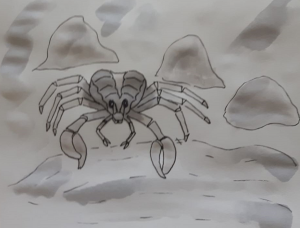Difference between revisions of "Stone Scabs"
From World of Entorais Wiki
Jump to navigationJump to search (applied template) |
m (Text replacement - "Sub-Species" to "Notable Sub-Species") |
||
| (7 intermediate revisions by the same user not shown) | |||
| Line 1: | Line 1: | ||
== | [[File:cave_crab.png|thumb|right|100x|Cave Crab - "Sebastian Romu" © 2019]] | ||
==About== | |||
;Common Names: | ;Common Names:Cave Crabs, Stone Scabs | ||
:Cave crabs, or stone scabs, are a variety of land crab which are nocturnal scavengers. In dry climates they can be an indicator of a hidden or underground watersource. | |||
==Description== | ==Description== | ||
;Classification: | ;Classification:Arthropod | ||
;Size: | ;Size: | ||
;Appearance: | ;Appearance:Stony grey crustaceans, In live cave networks they can develop a hardened crust of mineralization making them more easily camouflaged in their habitat. | ||
;Sexual | ;Sexual Dimorphism: <!--note differences between the sexes--> | ||
;Variance: <--any other variance, include subspeciation--> | ;Variance: <!--any other variance, include subspeciation--> | ||
==Ecology== | ==Ecology== | ||
;Habitat: | ;Habitat:Tropical to temperate latitudes, Rocky terrain, containing underground caves, piles of lose scree, or containing crevices an holes they can retreat into by day. A nearby source of freshwater. | ||
;Diet: | ;Diet:Scavenging omnivores, eating a variety of mosses, fungi, algae, plants, and carrion. | ||
==Behaviour== | ==Behaviour== | ||
;Social | ;Social Grouping:Found in groups numbering up to dozens of individuals, but without a notable pattern. | ||
;Temperament: | ;Temperament:Skittish. | ||
;Intelligence: | ;Intelligence:Animal | ||
;Reproduction:<--method, cycles, associated behaviours--> | ;Reproduction:<!--method, cycles, associated behaviours--> | ||
==Sub-Species== | ==Notable Sub-Species== | ||
<--list of sub-species with notable differences--> | <!--list of sub-species with notable differences--> | ||
==Domestication== | ==Domestication== | ||
;General:<-- | ;General:Generally not a prolific breeder, and slow growing, making them unsuitable for domesticated farming, but some are hunted or trapped for food. | ||
; | ;Resources:Meat, Shells. | ||
==Stories== | |||
<div style="column-count:3;-moz-column-count:3;-webkit-column-count:3"> | |||
</div> | |||
==See Also== | ==See Also== | ||
<--links to related material--> | <!--links to related material--> | ||
[[Category:Arthropod]] | |||
[[Category:Fauna]] | [[Category:Fauna]] | ||
Latest revision as of 01:36, 20 April 2023
About
- Common Names
- Cave Crabs, Stone Scabs
- Cave crabs, or stone scabs, are a variety of land crab which are nocturnal scavengers. In dry climates they can be an indicator of a hidden or underground watersource.
Description
- Classification
- Arthropod
- Size
- Appearance
- Stony grey crustaceans, In live cave networks they can develop a hardened crust of mineralization making them more easily camouflaged in their habitat.
- Sexual Dimorphism
- Variance
Ecology
- Habitat
- Tropical to temperate latitudes, Rocky terrain, containing underground caves, piles of lose scree, or containing crevices an holes they can retreat into by day. A nearby source of freshwater.
- Diet
- Scavenging omnivores, eating a variety of mosses, fungi, algae, plants, and carrion.
Behaviour
- Social Grouping
- Found in groups numbering up to dozens of individuals, but without a notable pattern.
- Temperament
- Skittish.
- Intelligence
- Animal
- Reproduction
Notable Sub-Species
Domestication
- General
- Generally not a prolific breeder, and slow growing, making them unsuitable for domesticated farming, but some are hunted or trapped for food.
- Resources
- Meat, Shells.
